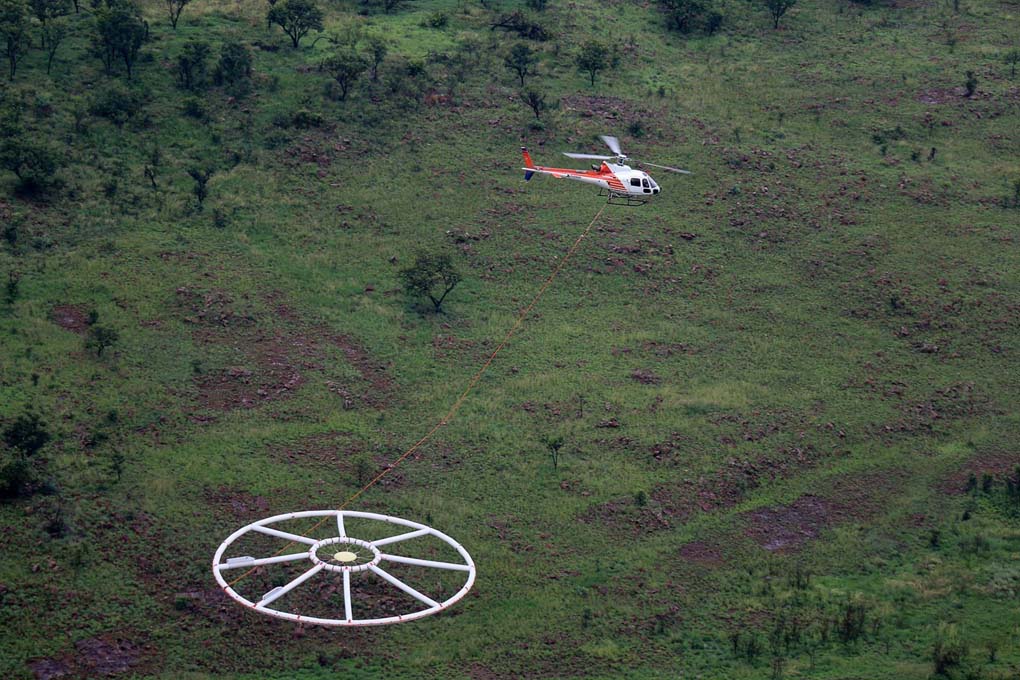
Australia based Margosa Graphite Ltd (Margosa), together with Lanka Resources and Mining (Pvt) Ltd (LRM) announced that it would commence an extensive high resolution Helicopter – Borne Time Domain Electromagnetic Survey (HTDEM) to accelerate its exploration search for new graphite deposits in Sri Lanka. The HTDEM survey was formerly introduced by Margosa’s Managing Director, Peter Venn at a function held in Colombo recently, attended by officials of the Ministry of Mahaweli Development & Environment, Ministry of Defence, Geological Survey and Mines Bureau (GSMB), Civil Aviation Authority, the Air Force, Air Senok, and other dignitaries.
Venn also announced that all necessary approvals have been received from the Geological Survey and Mines Bureau, Ministry of Mahaweli Development and Environment, and the Ministry of Defence in Sri Lanka.
Margosa has commissioned internationally respected geophysical company, New Resolution Geophysics (NRG™), to carry out the high resolution HTDEM survey, using their recently developed and leading edge “Xcite” airborne electromagnetic technology.
The Xcite HTDEM utilises a light weight inflatable loop, roughly 18 metres in diameter, which acts as a carrier for the system. The loop is securely fastened and suspended approximately 30 metres below a helicopter that flies 60-90m above the ground. The transmitter loop induces an electromagnetic field that measures the three-dimensional variations in conductivity within the near surface soil and rock. “The invisible magnetic field created in the process is harmless to the people and the environment,” stressed Varuna Mallawaarachchi, Chairman of LRM. Weather permitting, this HTDEM survey is due to commence within seven days, will take up to four weeks to complete and will see average flying times of four to six hours per day.. Air Senok, a highly respected Sri Lankan aviation contractor, will operate the AS350B Eurocopters, which will also include NRG pilots onboard each flight.

Background
The most commonly mined forms of graphite are flake or amorphous. Sri Lanka’s vein or lump graphite, is unique because of its high grades (90-99%Cg) and superior physical properties. These qualities make this vein product much sought after in the market and as such it retains a higher value when compared to these other forms of graphite.
Sri Lanka has exported its graphite to Asia, Europe and the USA for over 150 years with peaks in production between 1870 and 1918 and later during World War II. Sri Lanka remains the only country in the world to produce commercial vein graphite, but currently in low quantities (~8000 tonnes per year) from only two or three underground mines, and Margosa has a clear vision to rebuild the industry through the application of modern exploration and mine development techniques. To this end, it has strong technical Board and management team, each with over 25 years of experience in exploration, and mine development in Australia, Africa and Asia.
Margosa and Sri Lankan subsidiary LRM have been exploring and acquiring highly prospective graphite tenements in Sri Lanka since 2012. The company has 10 project areas covering 253 square km in the districts of Kalutara, Ratnapura, Kegalle and Matara. This initial HDTEM survey will be conducted over their Pathakada, Aluketiya, Dumbara, Kithulgala, Waharaka, and Dehiowita projects, which the Company consider as their Priority 1 target areas.
Margosa and LRM pioneered the use of modern electromagnetic (EM) surveying to explore for graphite in Sri Lanka, and early ground EM exploration over relatively small areas identified multiple targets on their Aluketiya and Pathakada properties. These areas were subsequently drilled, intersecting numerous graphite veins, providing the necessary proof that EM was an excellent exploration tool for vein graphite. Now with strong funding support from Australia, the Company believes that the NRG Xcite HTDEM system will quickly and efficiently deliver drill ready targets. “This Proof of Concept has led us to invest over A$500,000 in the largest (up to1700 line km) Airborne EM Survey to discover the next generation of Sri Lankan graphite deposits,” said John Shackleton, Chairman of Margosa.
The demand for graphite continues to surpass supply especially with the surge in lithium ion battery applications. Further, in his address on Friday, Mr Venn quoted Roskill’s 2017 published report “Natural and Synthetic Graphite: Global Industry, Markets and Outlook to 2026”, which forecasts that total global graphite demand in battery applications will increase between 16-26% per year to 2026. In addition to the battery market, Mr Venn also commented that “the number of new technological applications requiring high quality graphite is ever expanding in areas such as Aerospace Industries, Electronics, Fuel Cells and most recently Seawater Filtration -Desalination. Exciting new research into spherical and expandable graphite will also demand a high grade product with few impurities, which Sri Lankan vein graphite provides”.


